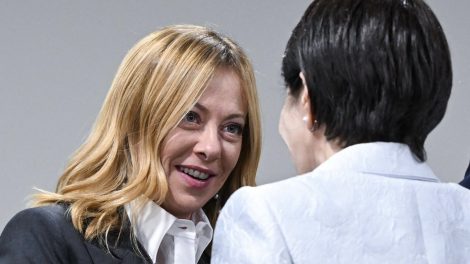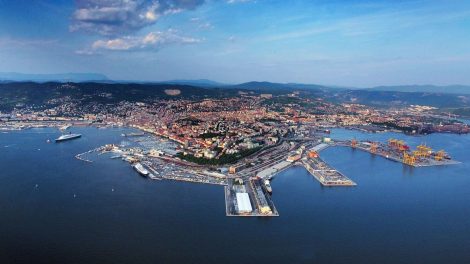For both countries, this rapprochement represents an opportunity to reset relations and bring Syria back onto the international stage.
Why she matters: Silvia Carenzi is an associate researcher at ISPI’s MENA Centre. Her work focuses on conflict, peace processes, and armed movements in Syria, based on extensive field research across Syria, Turkey, and Jordan.
Italy’s angle: One of the last European leaders Ahmed al-Sharaa met before travelling to Washington was Italian Foreign Minister Antonio Tajani, on the sidelines of COP30.
- The meeting underscored Italy’s growing diplomatic engagement in the region and its role as a bridge between Europe and the Middle East.
- Syria’s entry into the Global Coalition to Defeat ISIS also holds particular significance for Rome, which is an active member of the coalition and a key player in international counterterrorism efforts.
Q: The Syria of Ahmed al-Sharaa now presents itself as a U.S. partner after overthrowing Bashar al-Assad and curbing Russian and Iranian (and perhaps Chinese) influence. Yet the new order rests on Hayat Tahrir al-Sham, a movement with jihadist roots and a still-fragmented military structure partly composed of former fighters. How sustainable do you think this realignment toward Washington really is, and what internal factors could undermine Syria’s political stability and international credibility, especially in the context of reconstruction?
A: For both countries, this rapprochement represents a significant opportunity. After decades of isolation, Syria’s full return to the global stage and its renewed international legitimacy — especially after al-Sharaa’s speech at the United Nations last September — mark a significant shift. On the other hand, the U.S. regains an interlocutor in a country whose regime had been seen as a pariah since the Ba’ath Party’s rise to power.
- To make this rapprochement sustainable over time, the new Syrian government must skillfully navigate the delicate balances that characterise this transition — above all domestically, but also at the complex intersection between internal and international dynamics.
- An example of this is Syria’s inclusion in the anti-ISIS coalition, an adhesion that, according to recent reports and official statements, appears to be primarily political (coordination, intelligence sharing) rather than military.
- An article in Al-Monitor recently reported that Damascus asked Washington to end military strikes against ISIS members or suspects — unsurprising, given that many Syrians oppose foreign-led operations and would prefer Damascus to manage counterterrorism raids itself.
- Domestically, one of the main challenges is to mend the deep social fractures left by the Assad legacy and years of war, and to contain outbreaks of intercommunal violence before they escalate. These challenges have become even more urgent following spirals of violence on the Syrian coast and in Suwayda, last March and July, respectively.
- Closely tied to social pacification are the issues of transitional justice and accountability. The dossier on integrating the country’snortheast also remains open, following the framework agreement signed by Sharaa and Mazloum Abdi last March.”
Q: Damascus’s opening to the West, its inclusion in the anti-ISIS coalition and its potential participation in the Abraham Accords — with all the complexities of Israel’s engagement — mark a significant symbolic and strategic shift. What role can Syria play in a U.S.-led security framework (even one of “leading from behind”)?
A: According to recent statements from Damascus — and also according to what I have observed during my stays in Syria — the idea is not to join the Abraham Accords, but rather to negotiate a more limited security agreement, with the expectation that Israel will withdraw from the occupied territories after December 8, 2024.
- Since December 2024, the Syrian government has adopted what could be defined as a ‘zero problems’ policy. In reality, this is not entirely new to those who followed Syrian dynamics within the former opposition.
- Even in previous years, leading figures of Hayat Tahrir al-Sham (HTS) had articulated principles such as ‘neutralising’ (in the sense of not antagonising) potential adversaries and building ‘balanced relations’ with external actors.
- The idea of maintaining equilibrium with diverse interlocutors on the international stage and avoiding unnecessary conflicts seems to be a cornerstone of the current government’s foreign policy.
- In terms of regional order, al-Sharaa’s Syria presents itself as a country well integrated into regional partnership networks — from neighbouring Jordan to the Gulf states — and shares numerous points of interest with them, chiefly deconfliction and regional stability.
- Paradoxically, the history of HTS — an armed group with roots in the jihadist milieu — could offer Washington an opportunity to rethink the ‘War on Terror’ paradigm, at a time when the limits and counterproductive effects of traditional approaches are being increasingly debated.
- Recent years show that contact and dialogue with actors rooted in the jihadist milieu are no longer taboo in contemporary practice.
The bottom line: Under al-Sharaa, Syria is re-entering regional networks, seeking stability and balance while testing a fragile partnership with Washington. For Italy and Europe, the opening offers a new space for engagement in the Middle East’s evolving security architecture.





